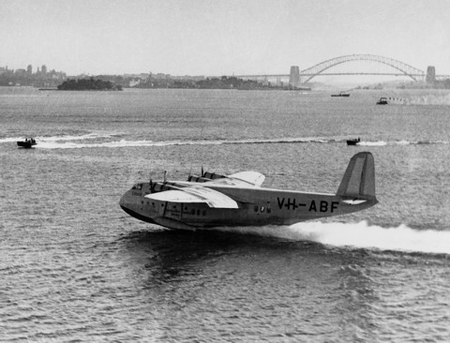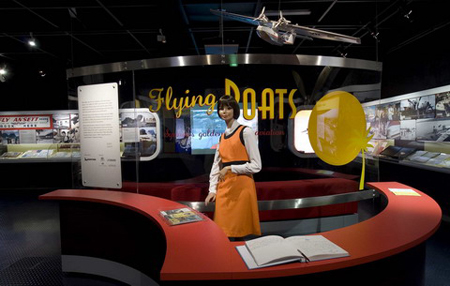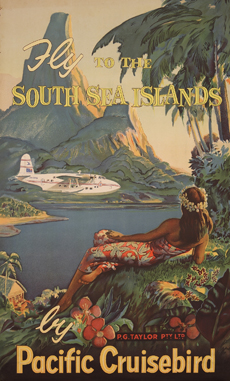review by Stephen Foster

RN Smith collection
Nostalgia can be a powerful drawcard for exhibition creators. It can also be a seductive trap. If some visitors do not share the experiences and memories that evoke nostalgia, there is a risk that they will be left behind.
Flying boats are the steam trains of the skies. Of course, they didn't have the staying power of steam, which dominated rail transport for over a century. The heyday of flying boats in Australia was brief, extending from the opening of the Rose Bay Base in 1938 until the early 1950s, when cheaper, faster and more efficient land-based aircraft replaced them on the route to London. A few of them remained in Australian skies until a landing strip was opened at Lord Howe in 1974, rendering them largely superfluous.
The exhibition traces the rise and fall of flying boats from the opening of Sydney's 'first international airport' 70 years ago, through the 'Golden Age of Aviation' (which might be mistaken to refer to the enormous cost of air fares) and wartime service, to holidays and honeymoons at Lord Howe. There is an even balance between the aircraft (mainly Empire Class flying boats, Catalinas and Sandringhams) and the people who flew and maintained them. There are some good stories, including the mysterious explosion and sinking of a Catalina at Rose Bay in 1949, a near encounter with a whale on Hayman Island, and the evacuation of prisoners-of-war from Singapore.
The curators had plenty of images and objects to choose from: posters from Qantas Empire Airways and other airlines long forgotten; cutaway diagrams of aircraft interiors, conveying the impression of space and luxury; timetables, maps and first-day covers; an abundance of photographs (perhaps too many); aircraft nameplates; a propeller from the Empire Class Coriolanus; and a control yoke (steering wheel) from the Sandringham that had flown me back from Lord Howe Island but was later wrecked there by a storm, towed out to sea and ignominiously scuttled. Flying could be hazardous: a well-worn Aircrew Operations Manual warns that high tide at the Lord Howe lagoon is 14 minutes less than the peak on Sydney Harbour. We learn elsewhere that aircraft had to land on the lagoon within an hour either side of high tide, so evidently it paid to be on time.
A mock-up of an Empire Class cabin includes a silver tea set from around 1940 and flight ephemera — but the bare frame gives little idea of the aircraft's roominess or the layering of decks that followed the shape of the hull. Parts of the exhibition are retold and developed in several minutes of contemporary footage, with comments by people with stories to tell about the flying boat era. The compilation is engaging, but the voiceover pervades the whole exhibition space, so that visitors trying to concentrate on the static display are compelled to hear the commentary before they see the film.
The era of flying boats came to an unhappy end. Although several Catalinas that served in Australian skies have survived, the last two Sandringhams from the Lord Howe route were sold to an American with a pipe dream of flying tourists around the Caribbean and along the east coast of the United States. The enterprise failed, but the Sandringhams survive in museums. The exhibition does not tell us where they are now, and there is no detailed accompanying website to satisfy the curious. This is a pity, as the subject matter deserves a continuing web presence, with links to more esoteric sites for the enthusiasts.
PG (Sir Gordon) Taylor lured tourists to the south seas in the mid-1950s with a romantic vision of rugged mountains, a blue lagoon, a Pacific beauty and a flying boat.
courtesy PG Taylor family
Through posters and photographs, the exhibition captures something of the 'romance' of the flying boat era. What's lacking is a sense of the experience of this form of travel: the misery of arriving at the city office long before dawn, only to be sent home again because of bad weather; the splutter and roar of the engines; the risk of getting wet as you jumped from the tender to the cabin on the choppy lagoon; the relief and excitement of getting into the air. All these are hard to evoke in a small space (though an imaginative soundscape would have helped).
The visitors' books help make up for what's missing, with good stories from former passengers and staff. One Sydney resident tells of travelling to Lord Howe in 1963 during squally weather. Many passengers were air-sick as the aircraft bounced through dense cloud. As the scheduled arrival time passed and the mood in the cabin became very sober, our informant decided to climb a ladder leading towards an observation blister to find out what was happening. There he found a crew member looking through binoculars and yelling into the cockpit, 'I can't see it yet, skip'. Evidently the island soon came into view, as the aircraft set down 15minutes later. Such stories deserve to be added to a website.
These and other contributions, many of them much longer than the usual guest book entry, testify that the exhibition works well for visitors who remember the flying boats. What does it mean to those who don't? Inevitably, the experience is less compelling. Nevertheless, comments from visitors who knew nothing of the era suggest that the exhibition hits the mark, reminding us that nostalgia for the past does not depend on having been there.
Stephen Foster is one of the editors of reCollections.
| Institution: | Museum of Sydney (Historic Houses Trust) |
| Exhibition team: | Matthew Holle, Beth Hise, Joanna Gilmour, Bob Whight, Caroline Lorentz, Lisa Hayes, Rhiain Hull, Tim Girling-Butcher, Justin Maynard, Alice Livingstone, and film by Afterglow productions |
| Design: | Kieran Larkin, Beau Vandenberg |
| Exhibition space: | 132 square metres |
| Venue/dates: | Museum of Sydney, 10 May – 14 September 2008 |
| Publication: | $2 room brochure |
